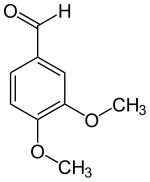Veratraldehyde
 | |
| Names | |
|---|---|
| IUPAC name
3,4-Dimethoxybenzaldehyde | |
| Other names
Methylvanillin; Veratric aldehyde; Veratral; Veratryl aldehyde; Veratrum aldehyde; Vanillin methyl ether | |
| Identifiers | |
| 120-14-9 | |
| ChEBI | CHEBI:17098 |
| ChEMBL | ChEMBL1088937 |
| ChemSpider | 21106008 |
| |
| Jmol-3D images | Image |
| PubChem | 8419 |
| |
| UNII | UI88P68JZD |
| Properties | |
| Molecular formula |
C9H10O3 |
| Molar mass | 166.17 g·mol−1 |
| Appearance | Peach coloured crystals |
| Density | 1.114 g/mL |
| Melting point | 40 to 43 °C (104 to 109 °F; 313 to 316 K) |
| Boiling point | 281 °C (538 °F; 554 K) |
| organic solvents | |
| Hazards | |
| Main hazards | Harmful |
| Except where noted otherwise, data is given for materials in their standard state (at 25 °C (77 °F), 100 kPa) | |
| | |
| Infobox references | |
Veratraldehyde is an organic compound that is widely used as a flavorant and odorant. The compound is structurally related to benzaldehyde.
This compound is popular commercially because of its pleasant woody fragrance. It is derivative of vanillin, from which it is prepared by methylation.[1]
References
- ↑ Karl-Georg Fahlbusch, Franz-Josef Hammerschmidt, Johannes Panten, Wilhelm Pickenhagen, Dietmar Schatkowski, , Kurt Bauer, Dorothea Garbe and Horst Surburg "Flavors and Fragrances" in Ullmann's Encyclopedia of Industrial Chemistry, Wiley-VCH, Weinheim, 2003. doi:10.1002/14356007.a11_141